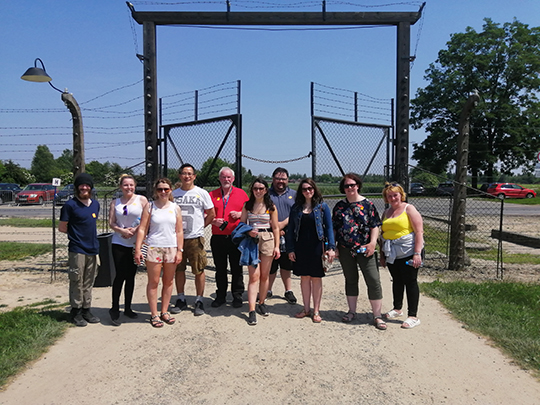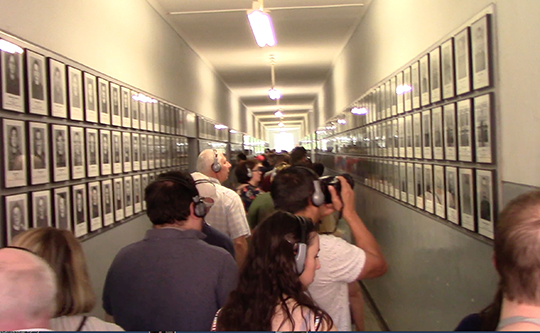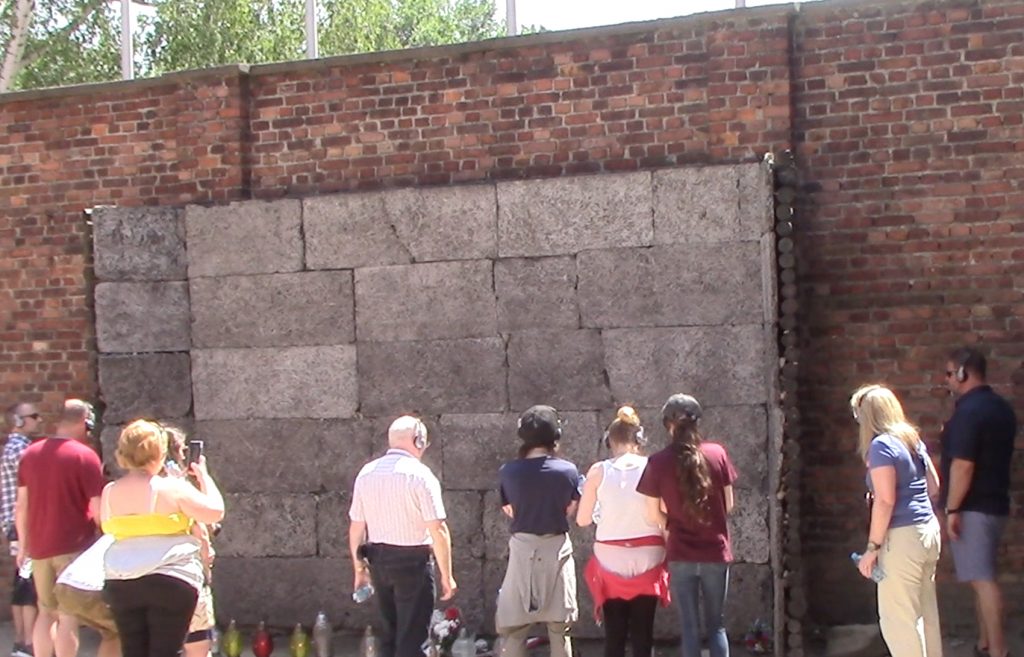A visit to Auschwitz-Birkenau concentration camps near Krakow in Poland.
This week I paid a trip to Krakow in Poland on a Peace 1V supported programme for good relations and diversity organised by the Clanrye Group in Newry.

There will be an official report on this trip coming out soon, but I just felt it was important to put on record my personal experience in visiting Auschwitz-Birkenau camps by way of ‘processing’ this visit.
Auschwitz was a slave camp mostly, but its darker side was that it did exterminate mostly Jews and other groups of people, whereas Birkenau was literally an end-of-the-line extermination camp.
It was a very hot day just over 30 degrees when we arrived by bus. I bought a mineral water, visited the toilet, and was welcomed, whereas Jews would have arrived in cattle trucks – the rails that were still visible, and they would have been shown the greatest disrespect, treated as sub-humans, and they would have been quickly stripped of all of their human dignity and possessions. I have often pondered on the words “Arbeit macht Frei” but never thought I would be walking through the gate with that sign above me where 1.3million human beings walked to their deaths, mostly Jews.

It was a guided tour. In English. But there were dozens of other tours ongoing in various languages and the camp was literally packed. There were many Chinese there, and given they had their experiences of concentration camps during wars with the Japanese, it brought it home to me that Auschwitz was not a one-off extermination plan historically specific to WWII or the German Nazi ideology. These ‘industrialised killing and disposal factories’ have been going for a hundred years and in some shape or form still do.
In 1941-42, the Germans cleared the local population of Poles from the area around Oswiecim district outside Krakow – some were sent to work in factories, and the Jews, ie about 80% of the local population, were sent to live in ghettoes which were in turn were later collection points for extermination. The houses in the area were destroyed and it became a command area for the camps’ workshops, stores, administration and barracks. The militarised extermination machine was highly sophisticated. The vast design and layout of Auschwitz itself is one of efficiency and order, a factory of death.

In viewing the various exhibitions in the orderly brick buildings, I felt increasingly nauseated that one race of people could treat another with such hatred. But the Nazis were governed by the demand for Lebensraum (living space) for their Ayran race. They believed in eugenics, and that their race was superior to others. They did not tolerate ‘miscegenation’, that is the genetic mixing of other races with the Aryan strain.
Around me I saw many people stressed, some daubing tears, others unashamedly letting tears run down their faces, and everyone was in a sombre, numbed mood at the shear scale of the extermination efforts. To me, this dulling of the senses must have been something too that affected the Jews and other prisoners when they arrived through the gates.
As the tour progressed, walking past electric fences and guard posts, there were exhibitions inside the buildings of mounds of thousands of shoes, piles of women’s hair, nail brushes, clothes, suitcases with names… one group member, said she spotted her family name (Rogan) on a suitcase there, and there were a few Irish people too who found themselves in these death camps, a little known fact.
One dismal block of cells was designed for prisoners set to die – to starve to death. Five prisoners were forced to crawl in through a small hole into a room 6×6 feet and left to starve. The cells below ground were ‘secure’ and oppressive, adding to the deterministic reality of where your stay there was going. And next to this particular cell block was a wall outside, a wall where thousands of people were shot dead.
On one corridor, at the end, I noticed a familiar structure, which blended in to depressing scene… a gallows. The process was to remove all traces of human dignity through sensory perception, beatings, starvation, dehydration, nakedness, exhaustion etc. Women were on one block only allowed to use the toilet twice a day.
But the most sickening, chilling moment was in walking through the gas chambers. There were cradles by furnaces at the exit there to drop the corpses onto to push into the furnace. The gas chambers themselves had solid concrete walls, literal tombs, with two doors only, and a vent to drop in the Cyclone B gas which caused their deaths. There was one exhibition where thousands of Cyclone containers were piled up – a macabre symbol of death.
The children were usually separated from their parents shortly on arrival and those that were sent of for experiments such as being injected with Typhus and other deadly diseases died horrible deaths, and the others were told they were going to ‘get a shower’ within hours usually as they had little economic value.
The industrialisation of human disposal was embarked upon with German efficiency. Little that was of value was wasted. Gold teeth and filling were extracted and a gold bar a day was created from this disgusting practice.
The evidence after the war was gathered and formed a significant part of the Nuremberg War Trials. There is a huge archive on Auschwitz-Birkenau camps comprising 39,000 photo negatives, 2500 family photos, several dozen ariel views, and many camp documents and records. So historical revisionists would have a difficult job denying the Holocaust ever existed.
The last execution at Auschwitz on 6 January 1945 of 60 Poles took place as the Russian forces advanced and the prisoners were being moved to other ‘safer’camps.
It was at this time a psychotherapist called Victor Frankl, a Jew, and an Auschwitz survivor, wrote a memoir of his stay there which helped shape his existential psychotherapy which he developed. I read his book almost 20 years ago, but it came to life for me this week for the first time.
And the trip to Birkenau camp just a couple of miles from Auschwitz was also a sobering experience. It is not built up like Auschwitz. There is a gate arch where the train would drive through, and prisoners would climb down to be herded to cramped buildings where dehumanisation knew no bounds. I saw the ovens where they burned the victims, and it was numbing. The German SS blew up the three crematoria in an attempt to remove the evidence as the Russians and Allied forces closed in. At one crematorium stands a permanent monument to the dead.
Birkenau was one of the most evil extermination centres that operated during the war, and not only Jews were killed there but also Poles, other Eastern Europeans and races such as gypsies, and anyone that the Germans felt was inferior and antithetical to their race. But notably, the Polish intelligentsia was severely depleted in an effort to remove all forms of leadership, inspiration and hope from the Polish population.
I had always imagined the Jews in these camps as being overwhelmed by the reality of their imprisonment, but this was far from the truth. There was a resistance movement in the Auschwitz camp that developed, and this flicker of light must have brought hope to many. There was a plan to seize guns, and challenge the guards, but the war ended before this could be put into place. Sadly, many internees had given up hope after months and years of abuse and just decided to end it all by walking into the electric wire fences.
The biggest learning point for me on this trip was to consider that diversity is a fact of life in our world and if we challenge this and try and impose rules and even worse, an extermination programme, then there will be conflict, winners and losers, and a severe disruption to the wider framework, in this case European society.
This finally leads me on to my last point: it will take me months to mentally process what I have seen. When nations are at loggerheads, and races are fuelled by ignorance and hate, and leaders exploit fears and prejudices, a heavy mix of politics brews, one that gives off gases, that could ignite and once again set Europe alight.
In a nutshell, if there is one lesson I have taken away from Aushwitz-Birkenau… it is that we all must be more tolerant and respectful as human beings… and understand our boundaries.
… the alternatives are too serious to consider, based on what I saw at Auschwitz-Birkenau.
As a committed European, I believe evil must be resisted… in all its forms. Politicians may currently argue over what shape ‘Europe’ should take, but fundamentally, there is a core need across all European nations, a common denominator, that we must learn from history.
The cost is too high to ignore… and the responsibility falls on us all to keep a watchful eye on extremism manifested in many ways, sometimes under our noses, which begins with undermining tolerance and respect for others.
***
(My thanks to the Clanrye Group who organised this trip through Peace IV through the European Union. Check out the report on the trip later on in Down News.)
(More photos and video to come!)























